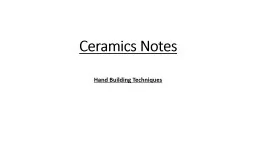

Hand Building Techniques Coiled Pottery One of the oldest ways of forming pottery Long strandssnakescoils of clay which are laid on top of each other and joined through slipping and scoring ID: 530687
Download Presentation The PPT/PDF document "Ceramics Notes" is the property of its rightful owner. Permission is granted to download and print the materials on this web site for personal, non-commercial use only, and to display it on your personal computer provided you do not modify the materials and that you retain all copyright notices contained in the materials. By downloading content from our website, you accept the terms of this agreement.
Slide1
Ceramics Notes
Hand Building Techniques Slide2
Coiled Pottery
-
One of the oldest ways of forming pottery. Long
strands/snakes/coils of clay which are laid on top of each other and joined through slipping and scoring. Slide3
Pinch Pots
- Starting with a
ball of clay the
potter opens a holeinto the ball and forms a bowl shape through a combination of stroking and pinching the clay. Slide4
Slab Built
- Clay slabs are cut to shape and joined together using
leather hard and wet clay called slip. Slabs can be draped over or into forms, rolled around cylinders or built up into geometric forms. Slide5
Stages of clay
Green ware
–
Clay that has not been fired. Wet clay – Clay in a
moist state. Firing – Heating a kiln to bake ceramics Leather hard clay – Clay in a firm
but sufficiently
moist state
to permit joining.
Bone dry clay – Clay in a dry state and ready to be bisque fired.
Bisque
– The
first
firing of clay, gets All
remaining water/moisture out
of clay.Slide6
Finishing and joining Techniques
Score and Slip
–
A method of joining two pieces of clay together. Scoring is when cuts/scratches are made in the two pieces of clay that are intended to be joined. S
lip is added to one side of the scored clay and then the two pieces are joined together. The slip acts like glue. This method does not work on bone dry and fired claySlip – super wet clay. It is often the consistency of thick cream.Glaze
- A coating of material applied to ceramics before
the 2
nd
firing that forms a glass/shiny or colored surface. Glazes can be colored, opaque, translucent or matte.
Sgraffito
- This comes the Italian word meaning
“to scratch"
and is done by incising or cutting a design through a colored
slip or glaze to
reveal the clay body
. We will be using this similar method to carve designs into the clay body itself.Slide7
The kiln
Kiln
- The oven in which ceramics are fired. Kiln Wash - used to coat kiln shelves to
protect them from dripping glaze. Kiln Shelves - The shelves inside a kiln that ceramic are placed on. Shelf Supports - Thick pegs/stilts
used to hold shelves in a kiln.
Pyrometric
Cones ( cones)
- These are slender pyramids of ceramics material made to measure and indicate when a firing is nearly finished or completely finished.